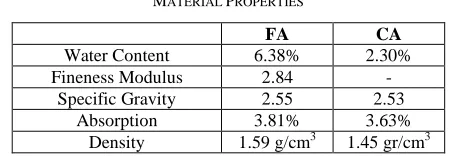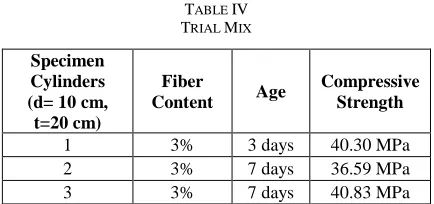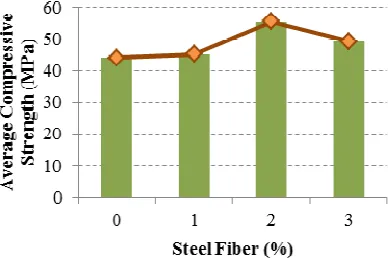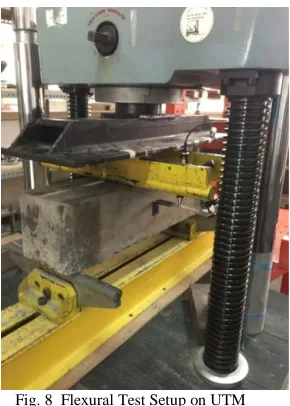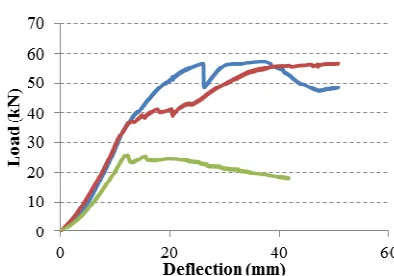Vol.8 (2018) No. 3
ISSN: 2088-5334
Experimental Study on High Strength Steel-Fiber Concrete
Sisi Nova Rizkiani
#, James Saputra
#, Johannes Adhijoso Tjondro
##
Civil Engineering Department, Faculty of Engineering, Parahyangan Catholic University, Bandung, Indonesia E-mail: sisinovaaa@gmail.com, jamessaputra77@gmail.com, jatjondro@gmail.com
Abstract—Concrete as one of the most used materials has been widely studied on its behavior, strength, etc. Concrete characteristic
could be observed from the cracks that are commonly found in concrete. Micro crack is one of the types of the concrete cracks. The appearance of micro cracks in the mortar aggregate interface is caused by the inherent weakness of plain concrete. The weakness can be reduced by randomly spreading micro reinforcement into the mixture. This study aimed to investigate the effects on the use of steel fiber on the strength of concrete with planned characteristic compressive strength of 60 MPa. Mix Design on this study referred to ACI 211 4R-08 and 4 (four) varieties of the concrete mixture is used. The varieties in the mixture will be determine by steel fiber content on the mixture, which is 0%, 1%, 2% and 3% of concrete volume. The mechanical properties to be tested in this study are compressive test, split tensile test, shear test and flexural test were conducted. Result data obtained has been analysed and compared with a control specimen which is concrete with 0% steel fiber. The specimen planned characteristic compressive strength is not achieved. The largest compressive strength obtained from this test is 56.38 MPa obtained from concrete with a 2% steel fiber mixture. However, result data clearly shows percentage increases in compressive strength, split tensile strength, shear strength and flexural strength due to the increases of the used steel fiber on concrete, while the ductility effect start occurred on the use of 2% steel fiber.
Keywords— high strength concrete; steel fiber; compressive strength; split tensile strength; shear strength; flexural strength.
I. INTRODUCTION
The behavior and concrete mechanical properties that have become common knowledge and also one of the weaknesses of concrete as a material are brittle and its minor ability to restrain tension force. Therefore, the use of concrete as a structural material can never be separated by the use of steel reinforcement. The addition of steel reinforcement in the concrete material is related to the lack of concrete ability in withstanding tensile stress. Thus, the combined material of concrete and steel reinforcement is commonly known as a reinforced concrete material.
On reinforced concrete structures design, the tensile stress that occurs is held by the reinforcement, while the concrete is being calculated in holding the compressive stress. The same principle is used to prevent cracks that occur when the tensile strength of the concrete is exceeded. Supposedly, the addition of steel reinforcement could reduce the appearance of the crack. The plasticity properties of the steel assist the brittle nature of the concrete. However, even after the addition of steel reinforcement, microcracks in the mortar aggregate interface mostly still appear. Microcracks are a microscopic crack on the material. On reinforced concrete, microcracks often appear near the tensile reinforcement and over the time, those fine cracks open the entrance for air and water. Combinations that can occur when air and water enter
then trapped in the same space with a metal material, in this case, is steel, chemical processes would occur, which is corrosion. This should be avoided because the corrosion that occurs in reinforcing steel will reduce the performance of the steel bar as a tension restraining component. So, the question is how to cope with or even prevent the emergence of microcracks on the concrete. The principle of adding steel to the concrete material is expected to remain applicable on a smaller scale. Steel in the form of small pieces known as steel fibers is used to test the idea. Steel fiber spread into the concrete mixture that expected to be micro reinforcement that scattered randomly.
On the other hand, with the rapid development of construction and building technology, for example, high rise buildings, long-span, and bridges, implicate with the demands of the availability of structural material with high specifications. The need for research on concrete as one of the leading construction materials is indispensable. High strength and high-performance concrete research is the most suitable one.
limited in the construction industry due to a lack of design guidelines in the codes. [1]
II. MATERIAL AND METHOD
A. Materials
1) High Strength Concrete: For mix made with standard
weight aggregates, high strength concrete (HSC) is considered to be the one having a compressive strength of more than 40 MPa [2]
2) Steel Fiber Concrete: According to ACI Committee
544 [3], Concrete with steel fiber concrete is defined as concrete made from a mixture of cement, fine and coarse aggregates and little steel fibers. Generally, the size of steel fiber used is not more than 76 mm in length, while its diameter is less than equal to 1 mm. The purpose of adding fiber is to provide fiber reinforcement in concrete, which is uniformly distributed to prevent concrete cracks in the area due to heat and hydration or due to loading. [3]
3) Steel Fiber: Dramix is an innovative steel fiber and
applied in industrial floor construction, warehouse floor, road pavement, basement parking, and wide-spread beam. Dramix is produced through a cold withdrawal process with a tip curve that will provide optimal binding. The advantage of using dramatic is to increase load bearing capacity due to redistribution of stresses, reinforcement on all sections provides excellent crack control, resistance to shock loads and dynamic loads, an enhancement which could lead to fatigue.
Fig. 1 Dramix (Steel Fiber)
B. Methods
The literature study is conducted as a reference to get a complete picture of the research. Literature studies include understanding the concept of high strength concrete with steel fiber, as well as the material selection, and mix design and testing methods to be used.
The experimental approach is used to find mechanical properties of steel fiber concrete. The tests were conducted at the Structure Engineering Laboratory of the Catholic University of Parahyangan. The material used for this experimental are cement, aggregates, water, steel fibers, and superplasticizer [4]. The mix design and the trial mix is calculated according to ACI 211.4R-08 [5]. As a preliminary test, the aggregate that will be used were tested using the standards of ASTM C127 [6] and ASTM C128 [7].
By varying the amount and the types of fibers in the concrete mix also the mechanical behavior varies. However, some shortcomings have been observed like their brittleness. The addition of steel fibers into the mix can improve the brittle behavior of High-Performance Concrete materials [8]. Hence, in this study, experimental conducted for 4 (four) variation of steel fiber content in the concrete mixture. Fiber content used in this experimental is 0%, 1%, 2% and 3% of the volume. Concrete with 0% steel fiber considered to be a control specimen.
C. Material Preparation
In advance of researching this study, it is necessary to prepare the material first. The materials used in the preparation of this research test are as follows: PCC Cement, fine aggregate with size less than 0.475 cm, coarse aggregate with size 0.9525 cm to 1.27 cm, water, superplasticizer and steel fiber. Steel fiber used for the experiment has characteristic given in Table I.
TABLE I
STEEL FIBER CHARACTERISTIC
Relative density (kg/m3) 7.8
Diameter (mm) 0.75
Tensile Strength (MPa) 1225
Young’s Modulus (MPa) 210000
Strain at failure (%) 0.5-3.5
Length (mm) 60
1/d 80
The fine and coarse aggregate properties strongly influence concrete as a composite material. The examination aims to obtain the quality of the planned natural compressive strength. The examination of the aggregate covers various aspects including water content test, gradation and modulus of fineness, specific gravity, absorption, and weight of contents. The recapitulation of material inspection is given in Table II.
TABLE II MATERIAL PROPERTIES
FA CA
Water Content 6.38% 2.30%
Fineness Modulus 2.84 -
Specific Gravity 2.55 2.53
Absorption 3.81% 3.63%
Density 1.59 g/cm3 1.45 gr/cm3
D. Test Specimen
There are 3 sizes of test specimens for each variation (0%, 1%, 2% and 3% steel fiber content:
• Cylinders with 10 cm diameter and height 20 cm for each variation of steel fiber content with the amount of 36 pieces used for concrete age factor testing, compressive strength test, and tensile strength test.
• Beam with size 10 cm x 10 cm x 30 cm for each variation of steel fiber content with the amount of 12 pieces used for the shear strength test.
E. Mixing Procedure
The mixture design of concrete which contain a proportion of cement, water and aggregates are essential. Concrete mix design is intended to achieve a specified compressive strength of the concrete. The mix design and the trial mix are calculated according to ACI 211.4R-08 [5]. After mix design is obtained, a trail mix is necessary for addition to test the planned slump value, the mixture cohesive, and the planned compressive strength, before mixing on a large scale.
Since trial mix result is suitable with compressive strength estimation, material and concrete mixing could be prepared. The concrete mixing procedure on this study was done the same as procedure mixing for regular concrete. The additional steps are the addition of superplasticizer into the concrete mixture (cement, fine aggregate, coarse aggregate, and water) and the addition of steel fiber. After the mixture is evenly distributed and achieved the desired workability, the fresh concrete could be poured into specimen formwork. High Strength Concrete and Steel-Fiber Concrete has low workability. Hence, Superplasticizer is being added to the mixture and works to improve the workability of the concrete based on ASTM C494 [4]. Fig. 2. shows the slump of the fresh concrete in this experiment with and without Superplasticizer.
Due to the low workability of High Strength Steel-Fiber Concrete, materials mixing became very important to ensure the homogeneity of the mixtures.
Fig. 2 Slump test without SP (left) with SP (right)
F. Testing Method
There are 4 (four) main tests to be performed on the specimen to know the mechanical properties of steel fiber. Compressive Strength Test, Tensile Strength Test, Shear Strength Test and Flexural Strength Test are to be conducted on this study.
1) Compressive Strength Test: The compressive strength test on the concrete aims to determine the compressive strength and characteristics of the concrete. Compressive strength test is conducted by Compression Testing Machine and refers to ASTM C 39 [9]. The maximum load restrained by the specimen was recorded. The compressive strength is calculated as the maximum load restrained is divided by the cross-sectional area of the cylinder.
2) Tensile Strength Test: The tensile strength test on the concrete aims to determine the tensile strength of the concrete. Tensile strength test is conducted by
Compression Testing Machine (CTM) and refers to ASTM C 496M-04 [10]. The maximum load restrained by the specimen was recorded.
3) Shear Strength Test: Shear strength test aims to determine the shear strength value of the concrete beam. A single point loading system is used, where loading is placed at the middle of the specimen span. This test is using Universal Testing Machine. Loads applied with constant and relatively moderate velocity on 0.3 mm/min until the crack and failure occur. The UTM record the load and displacement data.
4) Flexural Strength Test: Flexural strength test aims to determine the flexural strength value of the concrete beam. A three-point loading system is used, where each loading is placed on one-third of the supporting distance of the concrete beam and tested by Universal Testing Machine. This test is using Universal Testing Machine. Loads applied with constant and relatively moderate velocity on 0.6 mm/min until the crack and failure occur. Flexural test refers to ASTM C 78-09 [11]. The UTM record the load and displacement data.
III.RESULTS AND DISCUSSION
A. Concrete Mixture Proportion and Trial Mix
The planned characteristic compressive strength of this concrete is 60 MPa. The mix design and the trial mix is calculated according to ACI 211.4R-08 [5]. The material used on this calculation is based on the material test which had previously been described in Section II. Table IV shows the proportion of mixed concrete designs of each fiber content variation.
TABLE III
CONCRETE MIXTURE PROPORTION Materials
(kg/m3)
0% Fiber
1% Fiber
2% Fiber
3% Fiber
Cement 591.02 589.25 587.48 585.70
FA 642.39 640.46 638.53 636.60
CA 850.72 848.17 845.62 843.07
Water 188.69 188.12 187.56 186.99
SP 6.50 6.48 6.46 6.44
Fiber 0 24 48 72
Following the known proportion of the mix design, a trial mix is conducted before mixing on a real scale with the same type of materials that will be used on the real scale. The trial mix trial results are given in Table III.
TABLE IV TRIAL MIX Specimen
Cylinders (d= 10 cm, t=20 cm)
Fiber
Content Age
Compressive Strength
1 3% 3 days 40.30 MPa
2 3% 7 days 36.59 MPa
Normally, at the age of 3 days, concrete has reached 40% of the planned natural compressive strength. Trial mix result shows that the specimen exceeded 24 MPa, which is the 40% of 60 MPa. The specimen number 2 which is on the age of 7 days did not reach 65% of the planned natural compressive strength. On the other hand, specimen number 3 with same age has exceeded 39 MPa, which is the 65% of 60 MPa. Then based on trial mix result, with proportion which has been determined by mix design, have been appropriate to reach the compressive strength of characteristic equal to 60 MPa.
Specimen density of the concrete in every test was conducted and shows in Table V.
TABLE V AVERAGE CONCRETE DENSITY
Specimen 0%
Fiber
1% Fiber
2% Fiber
3% Fiber Compressive
& Tensile Test
2.358 2.375 2.355 2.386
Shear Test 2.375 2.494 2.444 2.475
The standard concrete density test shows the range of 2.355 to 2.494. This is the same value on standard concrete in general. It means the density of high strength concrete is not affected by the addition of steel fiber, because the added percentage is relatively small to specimen volume.
B. Compressive Strength
The compressive strength of cylindrical specimen is tested after 28 days in Compressive Testing Machine (CTM) Fig. 3 shows the average compressive strength of 3 specimens of each variation.
The compressive strength of plain concrete is lower than steel fiber concrete. Average values of compressive strength increased by increasing the fibers volume content. On concrete with 1% steel fiber showed a slight improvement of the peak compressive strength of about 2.5% compared to the plain concrete. On concrete with 2% steel fiber showed better improvement of the peak compressive strength of about 25.7% compared to the plain concrete. On concrete with 3% steel fiber showed improvement of the peak compressive strength of about 11.4% compared to the plain concrete. However, the compressive strength shows a better result on concrete with 2% steel fiber. This is may due to the uneven mixing of concrete because the more steel fiber added to the mixture, the workability become difficult. The addition of more metal fillers resulted in a decrease in compressive strength due to the presence of porosity. Further research needs to be done to ensure the statement is applied on steel fiber concrete.
On the other hand, the specimen planned characteristic compressive strength (60 MPa) is not achieved. Most likely, this is caused by uneven mixing and the incorrect usage of cement type. However, the final compressive strength on every specimen is still classified as High Strength Concrete.
Fig. 3 Steel Fiber vs. Compressive Strength
C. Split-Tensile Strength
The split tensile strength of cylindrical specimen is tested after 28 days in the compressive testing machine (CTM). Fig. 4. shows the average split tensile strength of 3 Specimen of each variation. The tensile strength of plain concrete is lower than steel fiber concrete. Average values of tensile strength increased by increasing the fibers volume content. On concrete with 1% steel fiber showed improvement of the tensile strength of about 39.4% compared to the plain concrete. On concrete with 2% steel fiber showed better improvement of the tensile strength of about 96.3% compared to the plain concrete. Similar to compressive test, concrete with 3% steel fiber shows a slightly differences with 2% steel fiber. On concrete with 3% steel fiber showed a tensile strength of about 95.98% compared to the plain concrete.
Fig. 4 Steel Fiber vs. Tensile Strength
Fig. 5 Post-Test Tensile Split Specimen
D. Shear Strength
The shear strength of beam specimen is tested after 28 days in Universal Testing Machine (UTM). Beam specimen size of 100 x 100 x 300 is prepared on Universal Testing Machine. The setup of the shear test is given in Fig. 6. Fig. 7. shows the average shear strength of 3 Specimen of each variation. Overall, test results show the average tensile strength and shear increases proportionally due to the addition of steel fiber.
Fig. 6 Shear Test Setup on UTM
Fig. 7 Steel Fiber vs. Shear Strength
The result of the shear test is slightly different from results on the compressive and split-tensile test. On concrete with 1%, 2% and 3% steel fiber shows the increase of the peak shear strength of 78.4%, 104,6%, and 124.1%,
respectively compared to plain concrete specimens. The value os shear strength of concrete with 2% and 3% is worth two times the strength of the plain concrete. This result indicates the addition steel fiber greatly help concrete to retain shear.
E. Flexural Strength
The flexural/bending strength of beam specimen is tested after 28 days in Universal Testing Machine (UTM). The three-point loading system is applied where each loading is placed on one-third of the supporting distance of the concrete beam tested by UTM machine. This system is chosen to ensure that to the failure of the specimen would be on the middle span of the beam which is no shear force due to an external load. The test is carried out with a loading speed of 0.6 mm/minute. Fig. 8. shows the specimen settings on flexural/bending test.
Fig. 8 Flexural Test Setup on UTM
The crack pattern of the post-test specimen shows that the specimen was failed on restraining flexural load. This was in accordance to the setup test. Then before analyzing further, it should be explained that the failure pattern on the whole test is on bending/flexural failure.
Based on the load and deflection data recorded by UTM, essential points of the test which are yielding and the ultimate point can be obtained. Once we know the value of these points, the ductility value of this concrete can be calculated. Fig. 9. to Fig. 12 shows Flexural Test Data in the form of Load versus Deflection on each Specimen with 0%, 1%, 2% a 3% fiber content respectively.
Fig. 9 Load vs. Deflection on 0% Steel Fiber-Concrete Beam
Fig. 10 Load vs. Deflection on 1% Steel Fiber-Concrete Beam
Fig. 11 Load vs. Deflection on 2% Steel Fiber-Concrete Beam
Fig. 12 Load vs. Deflection on 3% Steel Fiber-Concrete Beam On the other hand, a specimen with 1% fiber shows that after reaching the maximum load of 29.92 kN, did not sustain an immediate collapsed the specimen yet could sustain a gradually decrease loads. The specimen could not bear another added loads. Hence, the yielding point and ultimate of the test are on the same time/point on concrete
with 1% steel fiber. However, The steel fiber holds the specimen altogether after specimen started to crack and as expected works as the micro reinforcement.
The condition of the specimen with 2% fiber and 3 % fiber shows similar condition with 1% fiber specimen. After reaching the maximum load, the specimen did not sustain an immediate collapsed yet could sustain a gradually decrease loads. The maximum load of 2% fiber specimen up to 41,64 kN and the maximum load of 3% fiber specimen up to 57,46 kN. The average flexural strength increases proportionally due to the addition of steel fiber.
Similarly to the result of the splitting-tensile test, a specimen with steel fiber was not entirely separate after the test was conducted. Whereas standard/plain concrete (0% steel fiber) shows a brittle behavior, steel fiber concrete specimen shows more ductile behavior.
However, a better ductility is shown on 2% and 3% steel fiber specimen. On concrete with 1% steel fiber, the specimen could not gain more load after the first cracks. On concrete with 3% steel fiber could reach ductility value of 4.16. This indicates the addition of steel fiber helps the brittleness on concrete, which has been one of the most significant weaknesses of concrete. The steel fiber concrete did not fail immediately because the steel fiber had become the bridging agent when microcracks occurred. Displacement on yield load, displacement on ultimate load, peak load, ductility and Modulus of Rupture on every specimen of flexural/bending test is given in Table IV.
TABLEVI
DISPLACEMENT AND PEAK LOAD ON BENDING TEST Steel
Fibe r
Yield Disp. (mm)
Ultimate Disp. (mm)
Peak Load (kN)
Ductility
Modulus of Rupture
0%
8.69 8.69 21.40 1.00 3.45
8.57 8.57 27.57 1.00 4.35
4.93 4.93 20.86 1.00 3.34
1%
14.94 14.94 29.92 1.00 4.66
4.74 4.74 22.76 1.00 3.57
4.63 4.63 20.95 1.00 3.35
2%
9.23 25.75 32.71 2.79 5.27
11.24 21.64 41.64 1.93 6.53
10.85 30.01 38.37 2.77 6.22
3%
24.68 36.41 57.46 1.48 9.26
12.01 50.02 57.06 4.16 9.01
11.25 11.25 25.84 1.00 4.08
IV.CONCLUSIONS
The specimen planned characteristic compressive strength is not achieved. However, nonetheless, the final compressive strength is still classified as High Strength Concrete. The average shear strength and flexural strength increases proportionally due to the addition of steel fiber. Concrete ductility is indicated by the addition of ≥ 2% steel fiber.
REFERENCES
[1] Md Shahnewaz and M. Shahria Alam. Improved Shear Equations for Steel Fiber-Reinforced Concrete Deep and Slender Beams. ACI Structural Journal · July 2014.
[2] S.K. Duggal. Building Materials. New Age International Publisher Fourth Edition. 2016.
[3] ACI Committee 544.5R (2010): Report on the Physical Properties and Durability of Fiber-Reinforced Concrete. American Concrete Institute.
[4] ASTM C494. (2005). Standard Specification For Chemical Admixtures For Concrete.
[5] ACI 211 4R. (2008). Guide For Selecting Proportions For High Strength Concrete Using Portland Cement and Other Cementitious Materials.
[6] ASTM C127-15, Standard Test Method for Relative Density (Specific Gravity) and Absorption of Coarse Aggregate, ASTM International, West Conshohocken, PA, 2015, www.astm.org [7] ASTM C128-15, Standard Test Method for Relative Density
(Specific Gravity) and Absorption of Fine Aggregate, ASTM International, West Conshohocken, PA, 2015, www.astm.org [8] Adel Kaïkea, Djamel Achoura, François Duplan, Lidia Rizzuti. Effect
of mineral admixtures and steel fiber volume contents on the behavior of high performance fiber reinforced concrete. Materials
and Design. November 2014.
[9] ASTM C39 / C39M-17a, Standard Test Method for Compressive Strength of Cylindrical Concrete Specimens, ASTM International, West Conshohocken, PA, 2017, www.astm.org
[10] ASTM C496 / C496M-11, Standard Test Method for Splitting Tensile Strength of Cylindrical Concrete Specimens, ASTM International, West Conshohocken, PA, 2004, www.astm.org [11] ASTM C78 / C78M-16, Standard Test Method for Flexural Strength
